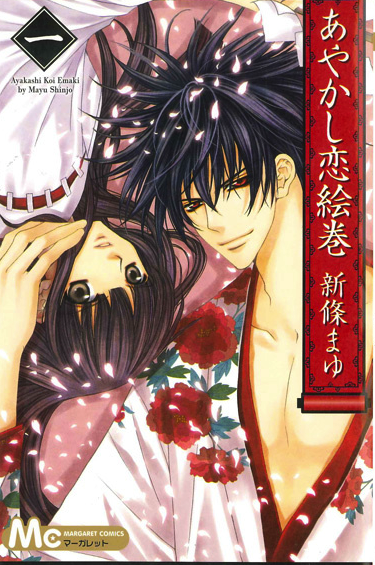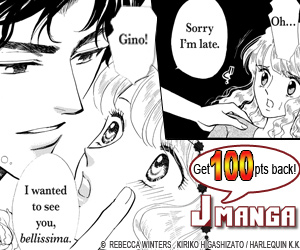Jmanga.com launched today, an online site that promises to deliver digital content from a variety of publishers. When I saw the site I was delighted to see that they were making some more obscure manga available, but as I investigated further I found myself a little disappointed by their payment model and pricing.
The site is organized by genre, making it easy to browse shonen, shoujo, seinen, and josei manga. The titles available range from manga already available in English (I spotted titles from Viz, Dark Horse, and CMX) to material that hasn’t been translated before. One of the things I was hoping for from Jmanga before it launched was that it would be a good source of josei manga titles. Unfortunately the josei selection is tilted heavily towards the boys love end of the spectrum, without featuring the office lady or paranormal romances I was wishing to read. The seinen section of the site seemed to have the most interesting possibilities for me as a reader. I was absolutely delighted to see that Jmanga had a translation of Ekiben Hitoritabi available. I’d heard about this manga featuring people riding trains and eating bento before, but I’d never expected to be able to read it. It was this title more than anything else that prompted me to sign up as a Jmanga user.
The pricing is one of the most problematic aspects of the site. Jmanga requires you to sign up for a $10 subscription, giving you 1000 points to buy manga with. Initial subscribers get a bonus of 500 points, but 1500 points doesn’t go very far on the site. As a monthly subscriber, you can purchase additional points when you’ve used up what you have. Individual chapters are as much as 290 points and single volumes are 899 points. This is problematic and I think not very sustainable pricing for digital comics. Emanga has single volumes for around $5, and so does the Viz iPad app. I tend to go for bargains when buying digital content. I’m perfectly happy to watch my k-dramas on streaming sites with commercials, without paying for a premium subscription. I tend to buy ebooks for the kindle when there’s a special sale. I buy digital comics through Comixology when they have items on sale. I buy manga on the Viz iPad app when it is discounted, but I do pay full digital price when I’m missing a volume. I would much rather have a “pay as you go” system on Jmanga.com. Being forced into a subscriber model annoys me. I also just do not enjoy reading manga on a web browser all that much, and view the iPad as an ideal method of reading digital comics. I hope an iPad version of Jmanga is going to be developed soon.
I ran through most of my 1500 points in an evening. This is what I read:
Ekiben Hitoritabi
This seinen manga will appeal to anyone who wants to feel like they’re taking a leisurely trip around Japan. Daisuke’s wife sends him on a slow train tour of Japan for an anniversary present. He loves the unique train station bentos he can get at each station that reflect the unique food culture of the area he’s traveling through. Daisuke is a genial guide to this aspect of Japan. He’s a large bearded man with a perpetual smile on his face. He meets a travel companion named Nana. She’s a journalist who is working on an article, and she enjoys eating almost as much as Daisuke does. There’s no real romance here, although Daisuke enjoys spending time exploring bento with Nana. Like many foodie manga, Ekiben Hitoritabi will make you want to eat. Each regional bento is lavishly illustrated, with diagrams pointing out all the different types of food packed into a small rectangular container.
Ekiben Hitoritabi is an exercise in notalgia as a slower, more rural Japan is showcased. Daisuke is riding in sleeper cars and slow trains, making stops along the way to visit hot springs or to buy the best locally made bento. No shinkansens here! Along the way we also get stories Daisuke tells of the unique models of trains he’s riding, local stories about how the railway was constructed, and illustrations of different types of engines. I have to admit, the bento descriptions appealed to me much more than the train history aspects of the manga.
The translation quality for the manga was fine, I didn’t notice any major typos or glitches other than the occasional odd turn of phrase. As with most foodie manga, the art excels in depicting food but Daisuke and Nana had much more fluid facial expressions than I was expecting, with Oishinbo as the main foodie manga I’ve read before. After reading this manga I know that one image will stick in my mind – Daisuke almost in tears hugging a prized bento to his face and Nana laughing at him. Ekiben Hitoritabi is the best type of foodie/travel manga because after reading it I really wanted to duplicate the type of trip Daisuke was on for myself. If you can endure the inevitable craving for bento and longing for Japanese scenery that Ekiben Hitoritabi will inspire, it is well worth the read.
My Sadistic Boyfriend
Switching to one of the few shoujo titles that looked interesting that hasn’t already come out in English, I decided to try out My Sadistic Boyfriend. This is a pretty typical shoujo title with attractive art that I think would appeal to fans of Miki Aihara. Chiaki enrolls in a prestigious school only to be told on the first day that she’s won a lottery and is going to be roommates with the “Prince” of the school, Katsuho. Does he immediatly start putting the moves on Chiaki? Does he have a Jeckyll and Hyde type personality? Is she bewildered yet strangely excited by his unwanted attentions? If you have to ask questions like these, you haven’t read a shoujo manga before! So there is not much new in My Sadistic Boyfriend, but it seems fine for what it is. I just liked the title.
The Larceny Log of Zampei the Cloud Snatcher
If you are a fan of Golgo 13’s Takao Saito, Jmanga is the site for you because it hosts a ton of his titles. The Larceny Log of Zampei the Cloud Snatcher is exactly what you’d expect from a Saito title set in historic Japan about the greatest womanizing thief ever. Zampei meets with a female client who wants him to steal a sword in a hot springs. Being a Saito hero, the details about the job and an incredible amount of exposition are spread over several pages while Zampei abruptly has sex with his client. I was truly amazed at the amount of backstory and details about the sword she wanted Zampei to steal the woman was able to convey considering the variety of positions she was contorted into. Even though Zampei is an awesome thief, he does have a fear of snakes which causes some complications when he goes out on the job. This title had by far the worst translation of the three titles I sampled. There were misspellings and word transpositions (faminine for feminine) that were really obvious.
The flash-based manga reader functioned ok, but sometimes lagged a bit when loading pages. I enjoyed the way I could toggle between English and Japanese in the reader. This seems like a potentially useful tool for Japanese language students.
After trying Jmanga out these are my hopes for the future:
- More variety available for shoujo and josei titles. I would also like to see authorized translations for some of the many orphan series we have that were left untranslated in the US. I would like to pay to read many of the unfinished series that were previously licensed by CMX.
- A better, more reasonable pricing scheme and subscription model. I signed up, but I’m not going to continue to subscribe for many months unless my points go further. They need to either lower prices or have some crazy sales for additional points in order to match what other manga companies are currently offering.
- Development of an iPad app
As a first try, there are aspects of Jmanga that are very promising. Being able to get series online from so many different publishers is certainly something to be excited about. I hope that in the next few months they work on some of the issues they had at the launch.


